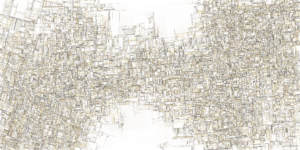Jared Tarbell began as a math and CS student and was already sophisticated at programming even before college. During his study, he realized how the complexity of the world could be divided into a set of simple rules, thus, he wanted to simulate some mysterious phenomena by computer, which shared a tremendous similarity in the sense that you only need to set a few simple rules to get a quite complex result. For his artworks, one can easily recognize that most of them are formed by multiple simple patterns interacting with each other. For example, in his work Substrate, the only shape you can find is straight lines growing on each other. These patterns only have slight differences, which clearly give little aesthetic value on their own but when combined together and add some randomness, they can form a system which is quite stunning. In his interview he also mentioned that he prefers creating simple rules, and the real time-consuming part is how to adjust parameters to better display the system. So the key feature of his work may be “simple shape, simple rules, complex system”. One more feature is his preference for dark colors, especially earthy yellow, and avoidance of using colors of high contrast, which give the audience a feeling of calmness and peace. On his development of artistic features, Edward Tufte inspired him a lot and made him realize the power of art and finally become an artist himself.

(Substrate by Jared Tarbell)
In CC Lab, the concept of generative art is creating something artistic by just setting a few simple rules, adding some randomness and letting the computer do the remaining job. Tarbell’s works are in line with this concept as they start from very simple shapes and rules and evolve to be complex systems.
His work inspires me to experiment with a set of simple rules and shapes at first, and gradually change parameters to see if some interesting patterns occur in my future project. To sum up, Tarbell began his career as a STEM student but later found his interest in generative art. I think the CS education he received played a vital role in inspiring him to develop his own art style, like creating a complex system by simple shapes and rules. And one thing I like about his projects is his delicate use of colors. They are dark and natural, creating a sense of flux with the pattern. You can feel these patterns are just like fluid or other things that exist in the real world and are simply quite comfortable to look at. From his artwork, I learned that compared with showing the complete system immediately, it’s more impressive to show the whole process of how the complex system evolves from simple shapes and randomness.
Leave a Reply